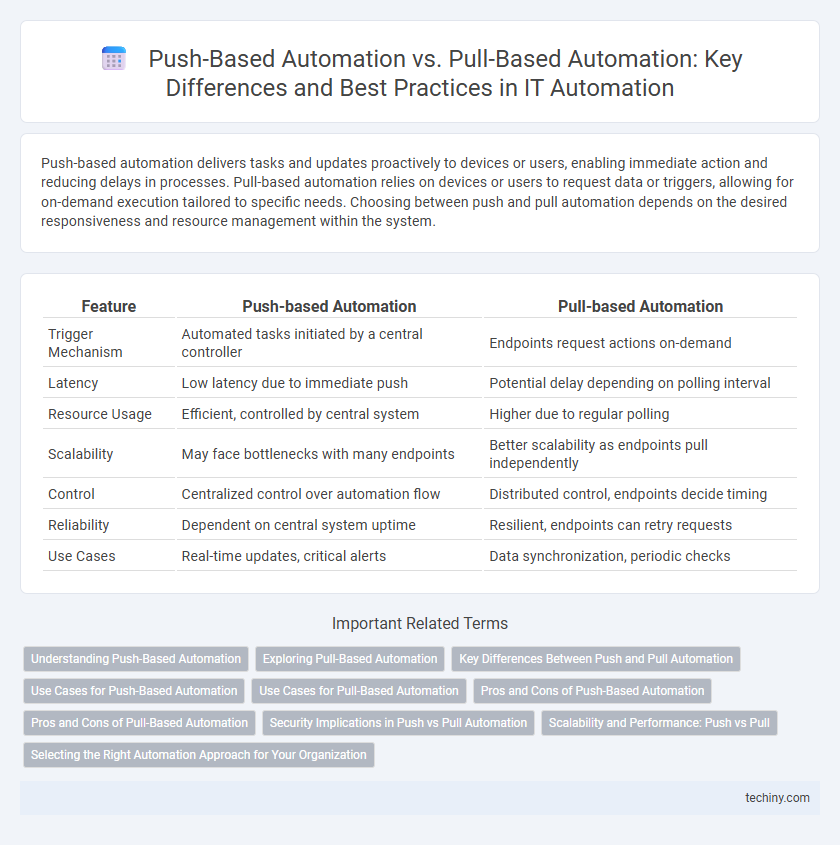Push-based automation delivers tasks and updates proactively to devices or users, enabling immediate action and reducing delays in processes. Pull-based automation relies on devices or users to request data or triggers, allowing for on-demand execution tailored to specific needs. Choosing between push and pull automation depends on the desired responsiveness and resource management within the system.
Table of Comparison
| Feature | Push-based Automation | Pull-based Automation |
|---|---|---|
| Trigger Mechanism | Automated tasks initiated by a central controller | Endpoints request actions on-demand |
| Latency | Low latency due to immediate push | Potential delay depending on polling interval |
| Resource Usage | Efficient, controlled by central system | Higher due to regular polling |
| Scalability | May face bottlenecks with many endpoints | Better scalability as endpoints pull independently |
| Control | Centralized control over automation flow | Distributed control, endpoints decide timing |
| Reliability | Dependent on central system uptime | Resilient, endpoints can retry requests |
| Use Cases | Real-time updates, critical alerts | Data synchronization, periodic checks |
Understanding Push-Based Automation
Push-based automation delivers predefined tasks and updates directly to target systems or devices, allowing centralized control and timely execution across distributed environments. This approach enhances consistency and reduces latency by initiating actions from a single control point rather than waiting for request triggers. Push-based automation is widely used in continuous integration/continuous deployment (CI/CD) pipelines and configuration management frameworks like Ansible, enabling efficient infrastructure provisioning and rapid deployment cycles.
Exploring Pull-Based Automation
Pull-based automation enables systems to request updates or data as needed, enhancing efficiency by reducing unnecessary processing and network load. Unlike push-based automation, which continuously sends information regardless of demand, pull-based methods optimize resource utilization by triggering actions only when specific conditions or user requests are detected. This approach is particularly beneficial in dynamic environments requiring real-time responsiveness and precise control over automated workflows.
Key Differences Between Push and Pull Automation
Push-based automation initiates processes by sending data or commands directly to systems, enabling immediate execution without waiting for requests. Pull-based automation relies on systems or users to request data or tasks, prompting automation to provide resources only when needed. Key differences include timing control, with push automation offering proactive task execution and pull automation emphasizing on-demand resource allocation.
Use Cases for Push-Based Automation
Push-based automation excels in environments requiring immediate, real-time responses such as alert notifications, incident management, and system updates, where actions are triggered instantly by events. This automation type is ideal for scenarios like security threat detection, where prompt intervention prevents breaches, and customer support systems that push updates directly to users. It enhances operational efficiency by minimizing latency between event occurrence and response execution, ensuring critical tasks are addressed without delay.
Use Cases for Pull-Based Automation
Pull-based automation excels in environments with unpredictable workflows or variable data inputs, enabling systems to request updates or actions only when needed. It is particularly effective in real-time data processing, on-demand resource allocation, and self-service IT operations where efficiency and responsiveness are critical. Industries like healthcare, finance, and cloud computing leverage pull-based automation to enhance accuracy and reduce unnecessary processing overhead.
Pros and Cons of Push-Based Automation
Push-based automation enables proactive task execution by automatically sending commands or updates from a central system to target devices, reducing latency and improving real-time responsiveness. It simplifies coordination in environments requiring immediate action but can cause network congestion and inefficient resource use due to frequent or unnecessary updates. Scalability challenges emerge as the system grows, since continuous pushing demands higher bandwidth and processing power.
Pros and Cons of Pull-Based Automation
Pull-based automation offers greater control and flexibility by allowing systems to retrieve specific data or tasks only when needed, reducing unnecessary processing and conserving resources. It enhances scalability and responsiveness, as processes are initiated on-demand, but may introduce latency or delays due to the need for continuous polling or request triggers. Challenges include potential complexity in system integration and the risk of missing real-time updates if pull intervals are not optimized.
Security Implications in Push vs Pull Automation
Push-based automation transmits updates and commands directly from a central server to target devices, increasing the risk of unauthorized access if the server is compromised. Pull-based automation requires target devices to periodically request updates, limiting exposure by ensuring devices authenticate themselves before pulling configurations. Security best practices recommend pull-based automation for environments requiring stricter access controls and minimizing attack vectors.
Scalability and Performance: Push vs Pull
Push-based automation delivers tasks and updates proactively, enhancing scalability by reducing latency and ensuring immediate execution across distributed systems. Pull-based automation relies on agents requesting data or instructions, which can limit performance due to polling delays and increased network overhead under high load. Scalability favors push models by minimizing resource consumption and optimizing real-time responsiveness in dynamic environments.
Selecting the Right Automation Approach for Your Organization
Selecting the right automation approach requires analyzing your organization's operational workflows and integration points. Push-based automation excels in proactive task execution by initiating processes based on predetermined triggers, ideal for environments demanding immediate responses. Pull-based automation suits contexts where tasks are executed upon request, providing flexibility and control over resource allocation and scheduling.
Push-based Automation vs Pull-based Automation Infographic

 techiny.com
techiny.com